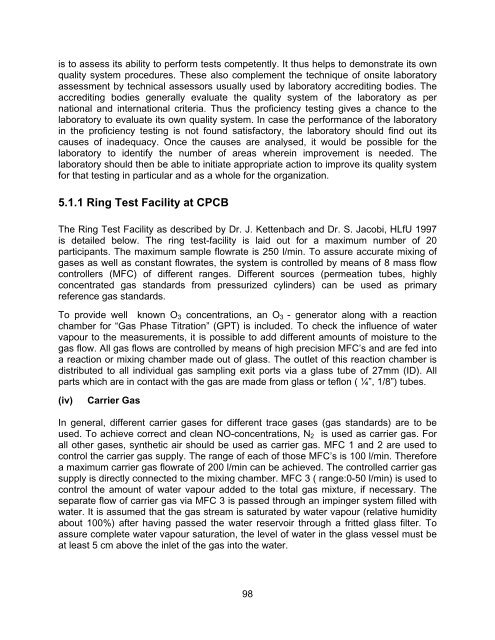Ambient Air quality Monitoring Guidlines. - Maharashtra Pollution ...
Ambient Air quality Monitoring Guidlines. - Maharashtra Pollution ...
Ambient Air quality Monitoring Guidlines. - Maharashtra Pollution ...
You also want an ePaper? Increase the reach of your titles
YUMPU automatically turns print PDFs into web optimized ePapers that Google loves.
is to assess its ability to perform tests competently. It thus helps to demonstrate its own<br />
<strong>quality</strong> system procedures. These also complement the technique of onsite laboratory<br />
assessment by technical assessors usually used by laboratory accrediting bodies. The<br />
accrediting bodies generally evaluate the <strong>quality</strong> system of the laboratory as per<br />
national and international criteria. Thus the proficiency testing gives a chance to the<br />
laboratory to evaluate its own <strong>quality</strong> system. In case the performance of the laboratory<br />
in the proficiency testing is not found satisfactory, the laboratory should find out its<br />
causes of inadequacy. Once the causes are analysed, it would be possible for the<br />
laboratory to identify the number of areas wherein improvement is needed. The<br />
laboratory should then be able to initiate appropriate action to improve its <strong>quality</strong> system<br />
for that testing in particular and as a whole for the organization.<br />
5.1.1 Ring Test Facility at CPCB<br />
The Ring Test Facility as described by Dr. J. Kettenbach and Dr. S. Jacobi, HLfU 1997<br />
is detailed below. The ring test-facility is laid out for a maximum number of 20<br />
participants. The maximum sample flowrate is 250 l/min. To assure accurate mixing of<br />
gases as well as constant flowrates, the system is controlled by means of 8 mass flow<br />
controllers (MFC) of different ranges. Different sources (permeation tubes, highly<br />
concentrated gas standards from pressurized cylinders) can be used as primary<br />
reference gas standards.<br />
To provide well known O3 concentrations, an O3 - generator along with a reaction<br />
chamber for “Gas Phase Titration” (GPT) is included. To check the influence of water<br />
vapour to the measurements, it is possible to add different amounts of moisture to the<br />
gas flow. All gas flows are controlled by means of high precision MFC’s and are fed into<br />
a reaction or mixing chamber made out of glass. The outlet of this reaction chamber is<br />
distributed to all individual gas sampling exit ports via a glass tube of 27mm (ID). All<br />
parts which are in contact with the gas are made from glass or teflon ( ¼”, 1/8”) tubes.<br />
(iv) Carrier Gas<br />
In general, different carrier gases for different trace gases (gas standards) are to be<br />
used. To achieve correct and clean NO-concentrations, N2 is used as carrier gas. For<br />
all other gases, synthetic air should be used as carrier gas. MFC 1 and 2 are used to<br />
control the carrier gas supply. The range of each of those MFC’s is 100 l/min. Therefore<br />
a maximum carrier gas flowrate of 200 l/min can be achieved. The controlled carrier gas<br />
supply is directly connected to the mixing chamber. MFC 3 ( range:0-50 l/min) is used to<br />
control the amount of water vapour added to the total gas mixture, if necessary. The<br />
separate flow of carrier gas via MFC 3 is passed through an impinger system filled with<br />
water. It is assumed that the gas stream is saturated by water vapour (relative humidity<br />
about 100%) after having passed the water reservoir through a fritted glass filter. To<br />
assure complete water vapour saturation, the level of water in the glass vessel must be<br />
at least 5 cm above the inlet of the gas into the water.<br />
98
















